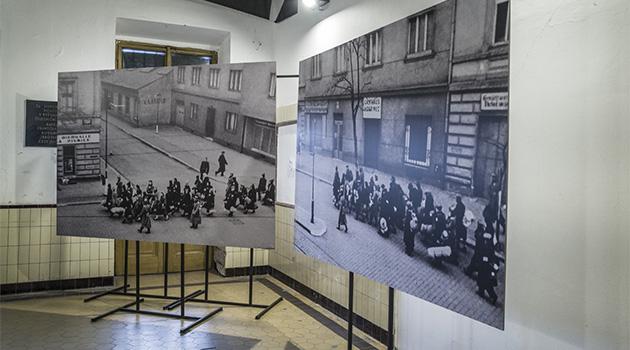Exhibition in Czech capital shows newly-identified photographs of the deportations of Jewish people from Prague during the Holocaust

The former train station in the Bubny neighborhood of Prague, which is being developed as a memorial to the cruelty of the Holocaust, has begun a series of exhibitions this fall. One presents photographs that have only been recently identified as documenting Jewish people walking through the intersection of U smaltovny and Veletržní Streets in the Holešovice quarter on the way to Bubny, the station from which they would then be forcibly deported to concentration camps.
The exhibition series, called “Images and Voices of Bubny” (Obrazy a hlasy Bubnů), will be on view until 31 October. The newly-identified photographs are from the collection of the author, photograph collector and researcher Jaroslav Čvančara.
The provenance of the photographs is unknown to the collector, who originally believed they documented Jewish people designated for deportation to the camps walking through the town of Bohušovice nad Ohří. For decades researchers have been under the impression that there was no photodocumentation of the march to the trains from different parts of the Holešovice quarter.
It is not yet known under what circumstances the photographs were taken, whom exactly they depict, or who took them. The Memorial of Silence (Památník ticha) organization wants to investigate the photographs together with experts, eyewitnesses, students, and any children from the families in the images who may still be alive.
Those visiting the exhibition will also see a small photograph album that was found among the possessions of the late Milan Weiner. A survivor of both Auschwitz and Terezín, Mr Weiner experienced a death march with his friend Arnošt Lustig, who later became a famous author.
Another part of Karel Cudlín’s cycle called “Babi Yar” will be exhibited, depicting the site of the massacre near Kyiv when, at the end of September 1941, more than 30 000 people were shot dead, as will the photograph cycle by Richard Homola called “Latent Images of Terezín” (Latentní obrazy Terezína), which captures details from the buildings in the former ghetto there. A display called “Passports for Life” (Pasy pro život) tells the story of a group of people who produced fake passports for Jewish people from all over Europe at the start of the Second World War so they could attempt to escape.
“Images and Voices of Bubny” is the event opening the fall program at the Memorial of Silence, the theme of which is transience. Starting today, 6 October, the public will be able to view a restored display of sculptures in the spaces of the disused tracks, along with new images of the biggest brownfield in Prague, called “Layers of Urban Memory” (Vrstvy paměti města), or take a walking tour with Zdeněk Lukeš to recall the German and Jewish architects of Bubny and Holešovice, while on 16 October the annual comemmorative event “Drumming for Bubny” (Bubnování pro Bubny) will be held.
The Memorial of Silence has been developed around the disused Bubny train station so far by a public benefit corporation and should become a state-funded organization of the Culture Ministry. That proposal has to be approved by the Czech Government.
The purpose of the Memorial of Silence is to tell the stories of what happened to members of the Jewish population in that particular location during the Second World War. The memorial is not just meant to be a remembrance site, but should house an educational center, a permanent exhibition, and have room for seasonal projects.
